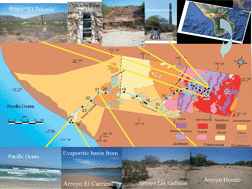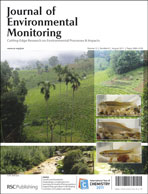Extensive waste deposits (tailings) and ash from the ignition oven of the abandoned gold mine of mining district El Triunfo (MD-ET) in Baja California Sur, Mexico have released trace elements into the sediments of the Hondo-Las Gallinas–El Carrizal arroyo, which connects to the Pacific Ocean through an evaporitic basin. Migration of these elements through the arroyo is mainly caused by winds or tropical hurricanes that occur sporadically during the summer and cause the otherwise dry arroyo to overflow. To evaluate the concentration and distribution of the elements As, Hg, Pb, and Zn along the 48 km arroyo, surface sediments were collected from 26 sites, ranging from close to the MD-ET to the mouth of the arroyo at the Pacific Ocean. Concentrations in tailings and ash were for As 8890 and 505 000 mg kg−1; for Hg 0.336 and 54.9 mg kg−1; for Pb 92 700 and 19 300 mg kg−1; and for Zn 49 600 and 1380 mg kg−1. The average of the Normalized Enrichment Factor (Av-NEF) in surface sediments, calculated using background levels, indicates that the sediments are severely contaminated with As and Zn (Av-NEF = 22), Pb (Av-NEF = 24) and with a moderate contamination of Hg (Av-NEF = 7.5). The anthropogenic influence of those elements is reflected in the arroyo sediments as far as 18 km away from the MD-ET, whereas the samples closest to the discharge into the Pacific Ocean show a natural to moderate enrichment for As and Zn and low or no enrichment for Hg and Pb. A principal components analysis identified four principal components that explained 90% of the total variance. Factor 1 was characterized by a high positive contribution of the anthropogenic source elements, especially As, Pb, and Zn (37%), whereas Factor 2 was strongly correlated with the oxy-hydroxides of Fe and Mn (27%). Factor 3 was correlated with Li (16%) and Factor 4 with Al (10%), which indicates more than one source of lithogenic composition, though they played a minor role in the distribution of the elements.


 Please wait while we load your content...
Please wait while we load your content...